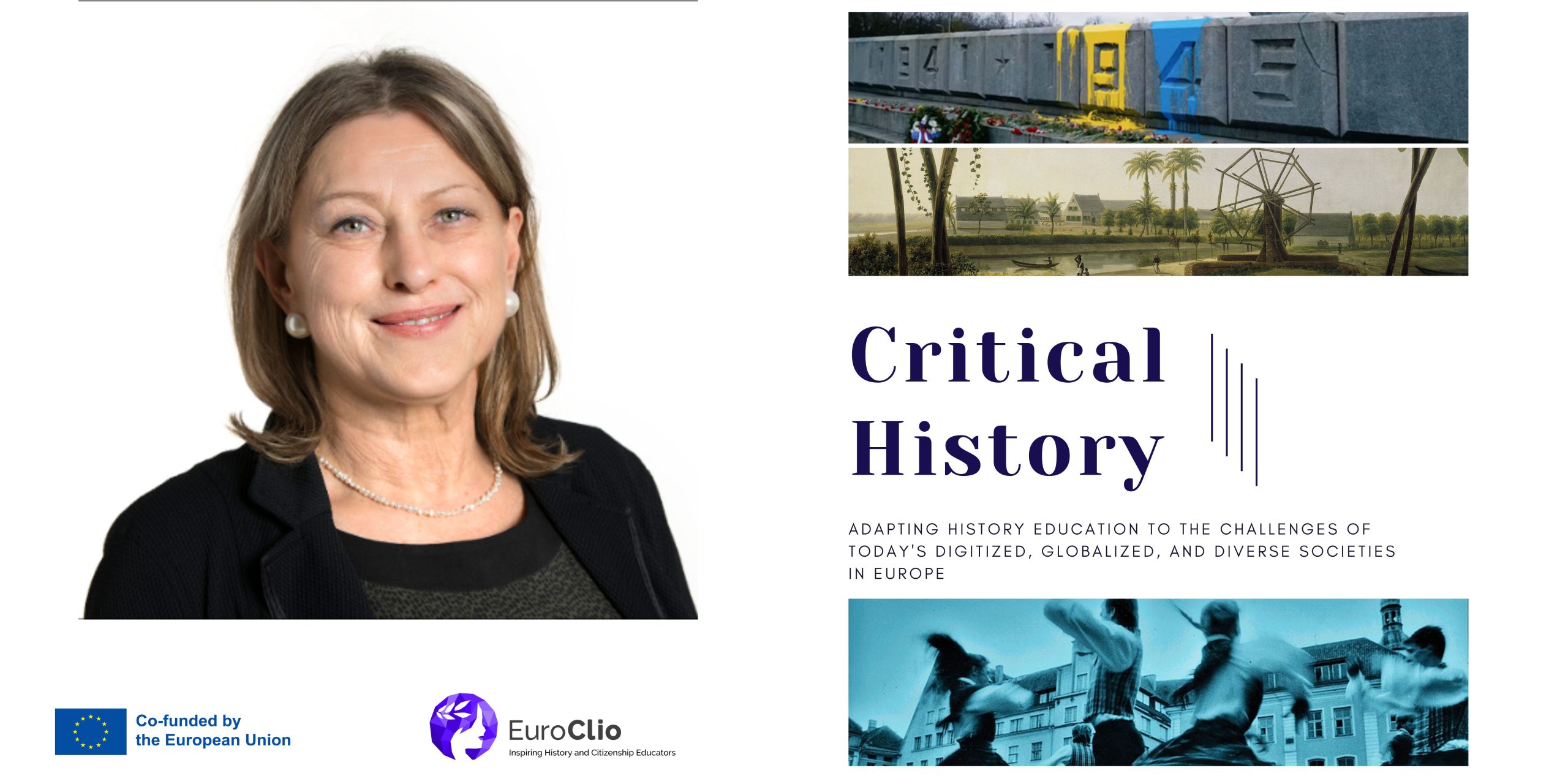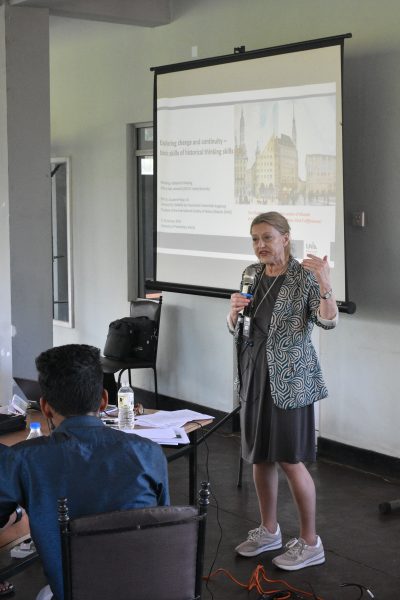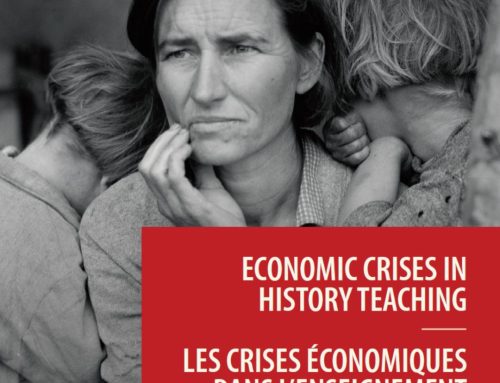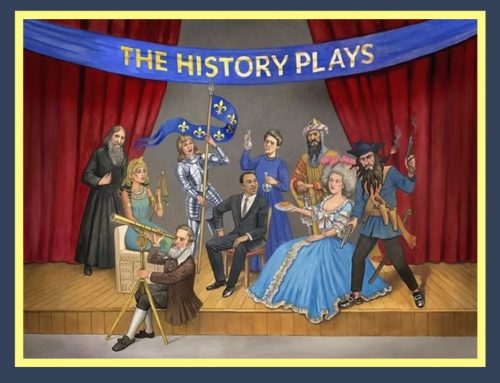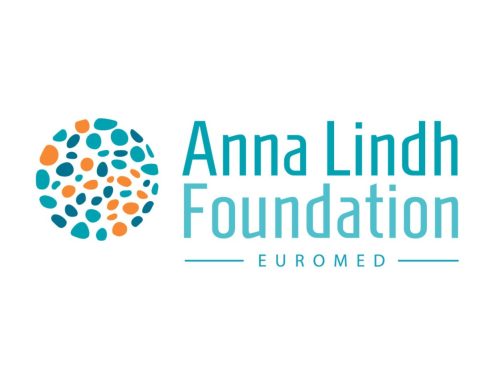EuroClio’s Adam Dargiewicz sat down with Professor Susanne Popp of Augsburg University (formerly also the president of the International Society for History Didactics), to discuss the joint project, Critical History, that Prof. Popp and EuroClio have worked on over the last three years. The project responds to several key challenges facing history education today, targeting students and history teachers, seeking to adapt history teaching to the realities of the 21st century. The project has resulted in a Study Guide, with chapters tackling heritage, the role and influence of the internet, global perspectives, and public history.
Adam Dargiewicz (EuroClio): Thank you for taking the time for this interview. First of all, why do you think we need to adapt history to the conditions of the 21st century?
Susanne Popp (University of Augsburg): Yes, of course… As to why, because the most common history education curricula and textbooks in the world are a product of the role of the history of nation building. Nation building was the beginning of history education for the [general] population.
The kings and the princes had their history education, but for the broad population, it started with nation building and the whole curriculum was to get some social creation by a certain idea of national history. And now I think it is evident that our nation states have changed very much in many aspects.
I think three main aspects. The first is more or less the globalisation that changes the structure and the function and the position of nation states. The second [aspect of change] is the big migration movement all over the world. And the third is the internet.
This means that the world of the students of today, if we look at that, first, they are living in the global and national framework of a nation state, which means school education, responsibilities, taxes, and so on. This is the framework of their existence, but their real life-world of communication and also outlook at the world is through the internet. They have a globalised life-world.
And the other [aspect of change] is migration. In Germany, for example, our capital Berlin, there are 60% of the students of the obligatory school that have a migratory background. And so, we have to ask if history education has the main intention to give an orientation to better interpret the life-world around you, and every life-world is a result of past developments. It’s a result of history. Then, we must ask what they need for their orientation. They need knowledge about the past, they need methodological competencies, that is clear. But is it enough to follow a national curriculum?
AD: And how can global history education help with that?
SP: Global history has in difference to the traditional world history, two points I will mention: The first is to see the local and the national in its broader historical context. The traditional national history had one bias that overestimated the internal factors of change because they wanted to describe how the German or Polish society developed and they underestimated the relationships which came from the outside, from transregional, macro-regional, or even global [influences].
It is also different to world history – this is the concept [where we study] one area of the world, one state, one major civilization and so on, additively to another. But global history is looking for connections, interactions, for communications, for adaptations, for resistance and so on. And not only everything that is good. Many people resist influences, but the main topic of global history is these interconnections. It is not to talk about China alone, but to talk about, for instance, Europe and China and the history of interactions between them. I think global history, not so much the traditional world history as a historiographical approach, has this in common with the life-world of the people today, and particularly of the young people. That interaction, communication, adaptation to follow something they see or to resist some things, this is, I think, really the close connection.
But I would like to add two things. There are only some countries in the world who teach something other than national history. This goes through all grades. In some grades they teach world history, say United States or Japan or China. But this world history is not including the national history of the country into its curriculum. So the students don’t have the opportunity to look at their own national history from the national historic point of view, and from a global [point of view]. In most countries we only have a national history.
We cannot substitute national history with any global history. No political system would accept it.
In the chapter of the study guide, I always talk about global perspectives for the national history. Because we cannot substitute national history with any global history. No political system would accept it. Because they need this knowledge about the historical understanding for civic education and for dealing with the problems of this respective country.
And so my idea, and this is also in the study guide, is to find ways, not for every topic, but really good topics that are suitable, to show the students that you can look at, for instance World War I or World War II, from a national perspective; What does it mean in national history and what does it mean in global perspectives? How the pictures differ, what is common, what is different?
And I think this change of perspective is, from my personal judgement, the most important point. At least from a didactic point of view. This perspective takes the idea of global history – and we don’t do global history as a subject at university, but we use it to give enriched perspectives and maybe also empowerment to these students with a migratory background to see a more inclusive perspective on national history.

Prof. Popp (third from right) with interviewer Adam Dargiewicz and project partners Dorota Wisniewska, Mare Oja, Joanna Wojdon and Andreas Holtberget (left to right) in The Hague, June 2023
AD: I was also wondering how the global historical perspective contributes to the development of critical thinking skills?
SP: Yes, it has many critical aspects. The first is of course to know that this national point of view is not the only one. This does not mean that it is not important and that it could not be the most important in certain questions, but for critical thinking, it is really important to know that there are other perspectives and that other perspectives are game changers. Mostly, not in every case, but very often.
Also, I do not talk about historical truth. For me, historical facts exist – I am not a deconstructivist – and I think history must go to fact and to make the differentiation between fact and fiction. But between fact and interpretation there is a lot of construction. And I think this is the first time where we get students who know by their education in school that there are different perspectives, that all have to be checked against facts and evidence. But, that [these perspectives] can have their different strengths or potentials and limitations in different countries, and I think this makes it easier to think critically about history. It does not mean to deny, but to know that there are different perspectives. And that the next important talk is to compare and to ask what is relevant. Is it convincing, what is ideology, what is fact, and so on.
AD: Given the fact that history curricula is very much nationally centred, they’re also overloaded most of the time. So how could teachers also find practical ways of globalising the topic that, for instance, they are obliged to discuss in class? Or expand it a little bit within this global perspective framework?
SP: This is maybe the most difficult question you have. I think often the national history is too detailed in the classroom because the students do not have a framework. I think if teachers would think, “what would I teach from a global perspective?,” that could help them evaluate what is really essential of national history and what are things that could be reduced in order to give a panorama, to have a macro picture. Students like to have big pictures, to see the structure and the whole, and then to think, “where is the position of my country?” This is much easier to understand as [compared to] a very detailed national history without a framework.
Why is it so detailed? I can give you an example from a German classroom. We do the French Revolution, in very, very much detail. We start with the preconditions and then four or five hours go by with the different steps of the development of the French Revolution and, I think, if we would make it more structured but not so detailed, they would see how it started, how the constitution came and then when they had the power, they had to fight for the directions and they were different, then the war came – more or less from outside – and this also changed it.
I think a more basic and wood-cut narrative would give more orientation and if you like, as a teacher, you can read some sources, maybe of Robespierre or whoever, and then it would be interesting to ask the question, “why, at this moment, did the revolution start?”
And what I have written about – and also tested – is to start with the Seven Years War. This was the first global war, and in this fighting between France and Britain for colonial predominance, they both weakened each other so much that first the British raised the taxes in the colonies and then the first problem arose. The same was in France where the farmers went hungry – you always have a revolution when farmers are hungry!
Then you see that financial bankruptcy came first, after which they had to call upon the “old participants” of the state processes to raise the taxes and then from this moment they then had the problems with the third estate. That they wanted to have the right to vote. I think this is something [students] can much better understand, as it is my experience with the 14-year olds. They understand that there was deep fighting about colonial history and weakness and then these many points came together. And from there, you could also go to the Haitian Revolution. [Students] like it so much because when you ask them, “all men equal?,” [they answer] “the women were not.” “Okay, but we talk about colonialism, what about the slaves?” And here I am a little bit critical about calling everything racist. Today we have a very ‘woke’ emphasis in everything, but most students, if you ask before history teaching, if black slaves ever made a successful revolution, most say it is impossible: that they could not do that because they had no education, they had nothing.
[As a teacher], this is something that you can do if you have six hours to start with the Revolution to come to Napoleon through to 1799. But you can have a much bigger picture and I feel that students ask much more if they are invited to see bigger pictures. They can better deal with it.AD: In your chapter, you convey an interesting point that global perspectives should not be presented to students as a history of the “other,” but rather, the history of humankind as a whole. Why do you think this is such an important distinction?
SP: I am not so ideological – Fridays for Future of course! – but I am not Last Generation and so on. But this deep climate crisis we have, which damage mostly the poorest countries. This is, I think, one of the first tasks where humanity has to cooperate because you cannot stop this very accelerated process only with the money from the United States or from Western Europe. You need all for that. And I think we need this idea of humanity in a global world, to see the main actor. Of course, many historians say humanity does not exist as an actor. That’s true. It is always people who act, but the category of thinking, this is something different and I think they should have in mind that there is a society, not only in nation and not only in the neighbourhood, but also through the globalisation of the world.
I think it’s an ethical and moral idea that we have to reintroduce humankind to historical thinking
I think it’s an ethical and moral idea that we have to reintroduce humankind to historical thinking and then make clear what is on the different levels. And this multi-level thinking is the same like changing the perspective. It’s necessary for critical historical thinking. And that is what I understand with critical history: not to criticise, say Napoleon, or some other topic – of course, you can do that too, but this is not the point I am dealing with.
AD: So should we be using terms and concepts such as the Global South, for instance?
SP: Yes, of course. And also, because if we talk about climate policies of the United Nations, they have these principles of differentiated, but shared responsibilities. And I always ask “what is [the expectation] from the Global South? What responsibilities are on their side?” Because I see, in our discourse in Germany, that the Global South are always portrayed as victims and they are always poor, etc. In many aspects, of course, they are, but they also have this category of mankind. They have agency, and they have responsibility. And this is why it is so necessary to talk about it and also go against positive prejudices.
AD: The final question is about the study guide as a whole. So, apart from the global perspective, it also talks about public history, heritage, and digital aspects. So how do you think the global perspective interacts? What are the synergies between these other elements that are also present in the study guide?
SP: Our idea was to get out four aspects that seem to be very necessary for today’s history education. Of course, with heritage, we have [a clear link with] global history. And also with immigrants in our classrooms, they have their own heritage, their own cultural memory and so on.
AD: Yeah, I was primarily thinking about the heritage aspect because especially now, we can also see all this contestation related to some elements of colonial heritage in many countries.
SP: This is the main thing that public history now has a strong accent on. Post-colonial, minorities, or indigenous knowledge and so on. And for me, the global perspectives are always for comparison. Not only to say, “okay, this was colonialism, we have this,” but how it is in other countries and how they dealt with revolutions, with changes in the political system. How do they deal with genocides? This is the global perspective; it is a comparative perspective.
And digital? You need it for the sources, of course.
AD: One of the teaching practices that is also included in your chapter uses the digital archives of the Red Cross which could be an interesting example.
SP: Yes, we stress more global perspectives on national histories than global history for its own sake. And I also included Big History because this is the history of mankind, but from quite a different perspective. It is to make students understand what their role in the whole system is. And I can only say that most students at the university, they have the feeling that humankind is very old, but they are always surprised that this last 10-12,000 years is the history where people settled down, where we have scripture, where we have sources. And they see, for the first time, that it is actually very short. While they come with the impression that human history is so long and no one can imagine what it is, this imagination is necessary for the appreciation of human history and answer to that.
The Anthropocene is the same, but from yet another perspective. I have prepared [work on the Anthropocene] through the lens of the Cold War – which is taught all over the world –from the idea of the global environmental history by John McNeil. The Great Acceleration. Because if you see these graphs [from McNeil’s work], you see that it was in the 1950s where everything exploded in an exponential way, until, in the 1990s, the results of human activities transcended the limits of self-organisation, of the planet of nature, as we say in the traditional way. And these traces will now stay with us forever, perhaps.
This is global perspectives on a certain time, and the most interesting thing is that we teach the Cold War mostly through a political approach as a social history about the opposites – these two systems fighting for global dominance and about the moral principles and what they did to the people. But, if you look at it from the perspective of global environmental history, you see they [the East and West] did everywhere the same way in order to achieve this dominance. They never thought about the environment because it was much more important to get to space, to get nuclear weapons, to get the industry, the oil and so on.
It is surprising to me how environmentally blind the whole historiography is
It is surprising to me how environmentally blind the whole historiography is. I never thought about it, that there are common traits – very strong during this period – while we normally only felt and experienced and teach the differences. When I ask students what gives them more orientation for their present situation, they discuss and they recite, and normally they conclude that the Cold War as a story of political opposites is not over. It came back and it will be very strong for the next decade, maybe not Communist and capitalist, but the United States and China, I think. But they also say it is very important to see how this political rivalry has made the people absolutely blind. And I correct them and say “they did not know that” –this is also to teach that the knowledge has changed so much. In the 1970s some people noted that things were not good, that the birds were dying, and the lakes were disappearing and so on. But everybody said “yes, but as technology progress, we will find the solutions to these issues!”. Nobody knew that it could be that we are coming close to a situation of tipping points, maybe that global warming goes over a certain level, and then the whole system that we have known for 12,000 years could change in an unforeseeable way. It must not be catastrophic, but it could be.
So, we bring together these two interpretations. Through the global perspective, it makes sense to highlight the old Cold War narrative because it is again very timely, but also to bring in the new [environmental perspective]. And so, this is global history in history education, in my eyes: that [the students] see these different narratives together.
AD: Thank you very much, Professor Susanne Popp, for this talk.
Critical History: Adapting history education to the challenges of today’s digitized, globalized, and diverse societies in Europe is an Erasmus+ Project (2020-1-EE01-KA201-077997) of the European Union. It is led by Tallinn University together with the universities of Salamanca, Augsburg and Wroclaw as well as EuroClio.
This project has been funded with support from the European Commission. This publication reflects the views only of the authors, and the Commission cannot be held responsible for any use which may be made of the information contained therein.

